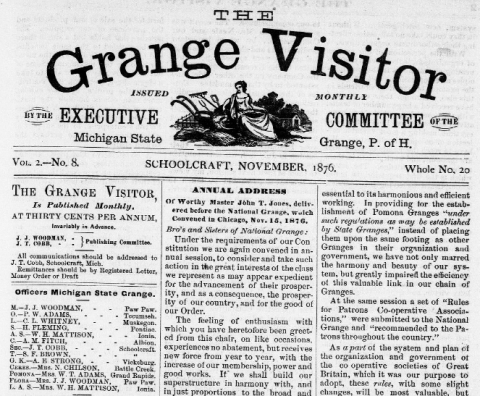The Grange Visitor, the official newspaper of the Michigan State Grange from 1875 to 1896, is online as a Michigan State University Digital Collection with support from Project CERES. Work to digitize, catalog, create issue-level metadata, and provide free and open web access to The Grange Visitor began in August 2013 and was completed in August 2014 by a Michigan State team led by Anita Ezzo, Science Collections Coordinator at Michigan State Libraries. With funding from the Center for Research Libraries, twenty-one volumes, 402 issues, and 3,239 pages are now preserved and accessible to researchers.
The Michigan State Grange is a delegate body, representing local and county granges’ interests to the Patrons of Husbandry, or the Grange. The Grange, begun in 1867, was organized as a national fraternal organization to bring farmers together for mutual social, political, educational, and economic benefits. The Grange was first of its kind to serve the interests of farmers in the United States and also the first fraternal organization to include women with full benefits of membership and opportunities to serve as officers within its governing structure.[i] Its 1874 Declaration of Purposes of the National Grange stated:
“We proclaim it among our purposes, to inculcate a proper appreciation of the abilities and sphere of woman, as is indicated by admitting her to membership and position in our Order.”[ii]
In the writings of many of the farm women who contributed to The Grange Visitor, one can find examples of their participation and influence.[iii]
The Michigan Grange formally joined the national organization in 1873, and its newspaper, The Grange Visitor, began publishing in 1875.[iv] It offers a rare glimpse into the agricultural history of Michigan while the country was rebuilding and reuniting after the Civil War. It tells this story through legislative updates, reports and news from the Michigan Agricultural College, recipes and advice for the homemaker, literary features, obituaries, and advertisements.[v] Its “Ladies Department” column became as much a forum for debate as a place to share a recipe, and offers unique insights into women’s thoughts on their own roles, rights, and responsibilities and the social, economic, political, and legal implications of their status.[vi]
Recognizing the value of The Grange Visitor to scholars and researchers of many disciplines, Michigan State University Libraries sought funding to digitize and preserve its almost complete holdings of the newspaper from the first issue in April 1875 to the final in December 1896. The funding came from the Center for Research Libraries under Project CERES, a collaboration between CRL, the United States Agriculture Information Network (USAIN) and the Agriculture Network Information Collaborative (AgNIC).
The digitized version of the newspaper is available through the Michigan State University Digital Collection. Michigan State has also made details about the project and links to its metadata and digital files for digital humanities research.
The digital files were scanned from microfilm created from print copies with funding from a National Endowment for the Humanities (NEH) grant.[vii] Uncompressed tiffs and searchable pdfs were created. Copies of the file will be maintained in Michigan State’s Fedora Commons, its institutional digital repository. Appropriate archival boxes were created to house print copies in Michigan State Libraries’ Special Collection Unit. The digital files and accompanying metadata were also obtained by CRL to host on its digital delivery system. The newspaper has also been registered in CRL’s ICON newspaper database.
The digitization and preservation of The Grange Visitor is an important contribution to the overall effort to preserve and make accessible essential agricultural resources for scholarship and research.
[i] Gardner, Charles M. Grange-Friend of the Farmer, 1867-1947: A Concise History of America’s Oldest Farm Organization, and the Only Rural Fraternity in the World. Washington, DC: The National Grange, 1949.
[ii] Ibid., "Declaration of Purposes of the National Grange."
[iii] Lowman, Jacquelyn A. “’'Reap what you sow!’ How the Michigan State Grange and its Grange Visitor gave rural women an opportunity to realize their truest selves." Journal of Agricultural & Food Information, Vol. 5(2) 2003.
[iv] Ibid.
[v]Ezzo, Anita. Michigan States’s Project CERES Final Report. 2014.
[vi] Lowman.
[vii] Michigan State University took part in Phase IV of the “Preservation of the Literature of Agriculture” project. For more information: http://neh-usain.mannlib.cornell.edu/

